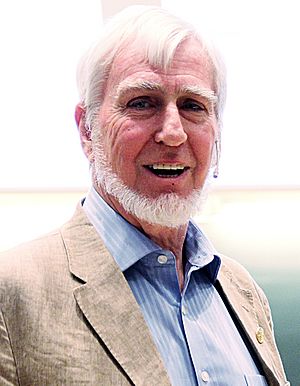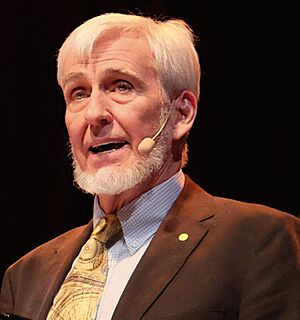John O'Keefe (neuroscientist) facts for kids
Quick facts for kids
John O'Keefe
FRS FMedSci
|
|
|---|---|

O'Keefe in 2014
|
|
| Born | November 18, 1939 New York City, U.S.
|
| Citizenship | United States United Kingdom |
| Alma mater | City College of New York (BA) McGill University (MA, PhD) |
| Known for | Discovery of place cells |
| Awards |
|
| Scientific career | |
| Fields | Neuroscience Psychology |
| Institutions | University College London |
| Thesis | Response properties of amygdalar units in the freely moving cat (1967) |
| Doctoral advisor | Ronald Melzack |
| Notable students | Neil Burgess |
John O'Keefe is a famous American-British neuroscientist and psychologist. He was born on November 18, 1939. He is a professor at University College London.
Professor O'Keefe made an amazing discovery. He found special cells in the brain called place cells. These cells help us understand where we are in the world. He also found that these cells use a special kind of "time code" to work. In 2014, he won the Nobel Prize in Physiology or Medicine. He shared this big award with two other scientists, May-Britt Moser and Edvard Moser. He has also received many other important awards for his work.
Contents
Early Life and Education
John O'Keefe was born in New York City. His parents were immigrants from Ireland. He went to Regis High School in Manhattan. After that, he studied at the City College of New York. He earned his first degree there in 1963.
His parents had not finished elementary school. But his father worked hard and got a high school degree in New York. John O'Keefe then moved to Canada. He studied at McGill University in Montreal, Quebec. He earned his Master's degree in 1964. Then, he got his PhD in Psychology in 1967. His teacher and guide for his PhD was Ronald Melzack.
Career and Brain Discoveries
After finishing his studies, O'Keefe moved to University College London in 1967. He started there as a research fellow. He has worked there ever since. He became a full professor in 1987. In 2014, he also became a part-time professor. This was at the Norwegian University of Science and Technology.
Discovering Place Cells
Professor O'Keefe and his student Jonathan Dostrovsky found place cells. They carefully studied how individual brain cells in the hippocampus reacted to different things in the environment. The hippocampus is a part of your brain important for memory.
They found that these "place cells" become active when you are in a specific place. Imagine a map in your brain. Place cells are like the dots on that map. They help your brain know exactly where you are. O'Keefe wrote many important papers about place cells. He also wrote a book with Lynn Nadel. This book explained how the hippocampus acts like a "cognitive map" for remembering places.
Understanding Theta Phase Precession
O'Keefe continued his research on place cells. He found something even more interesting. He discovered that place cells use a special "time code." This code helps them share information. It's about when the cells send their signals. This timing is linked to a brain wave called the theta rhythm.
In 1993, O'Keefe and Michael Recce showed how this works. When a rat enters a place cell's "firing field" (the area where it's active), the cell starts sending signals. As the rat moves through that area, the timing of these signals changes. This shows that the brain uses the exact timing of signals to understand what's happening.
Predicting Boundary Vector Cells
In 1996, O'Keefe and Neil Burgess made another important discovery. They noticed that place cells changed how they worked when walls or barriers in an environment moved. They created a model that predicted another type of brain cell. They called these "boundary vector cells." These cells would respond when an animal was a certain distance from a wall or boundary.
Years later, scientists found these predicted cells. They were found in parts of the brain called the subiculum and the medial entorhinal cortex. These cells act just as O'Keefe and Burgess had predicted. They help the brain understand the edges and boundaries of a space.
Awards and Honors

John O'Keefe has received many important awards for his work. He became a Fellow of the Royal Society in 1992. This is a very high honor for scientists in the UK. He also became a Fellow of the Academy of Medical Sciences in 1998.
Some of his other awards include:
- The Feldberg Foundation Prize in 2001.
- The Grawemeyer Award in psychology in 2006 (with Lynn Nadel).
- The Gruber Prize in Neuroscience in 2008.
- The Louisa Gross Horwitz Prize in 2013 (with Edvard Moser and May-Britt Moser).
- The Kavli Prize in Neuroscience in 2014. He shared this with Brenda Milner and Marcus Raichle. This award was for discovering brain networks for memory and thinking.
In 2014, he received the biggest honor: the Nobel Prize in Physiology or Medicine. He shared this prize with May-Britt Moser and Edvard Moser. They were recognized for their discoveries of cells that form a "positioning system" in the brain. This system helps us know where we are and find our way around.
After winning the Nobel Prize, he received honorary degrees from several universities. These included University College Cork, The City College of New York, and McGill University. These were special degrees given to him to honor his achievements.
In 2015, he was a guest on a BBC Radio 4 show called The Life Scientific. He talked about his amazing discoveries there.
See also
 In Spanish: John O'Keefe para niños
In Spanish: John O'Keefe para niños

